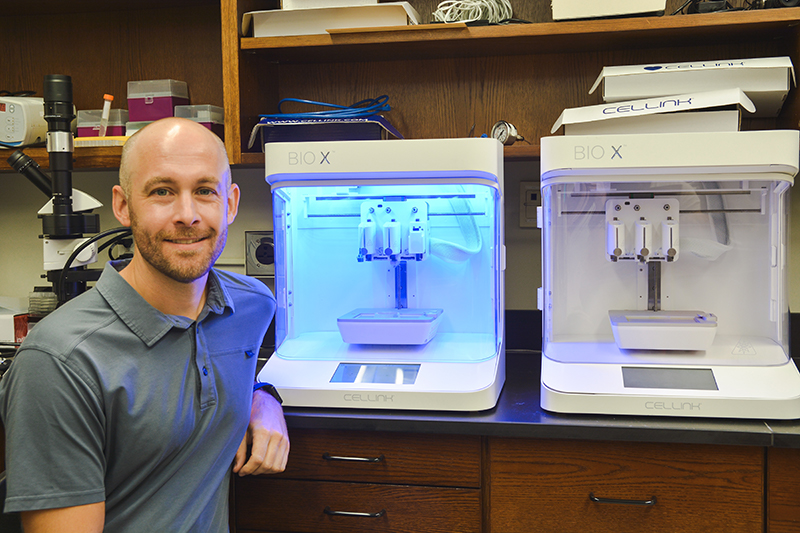
Andy Sarles with two bioprinters, which are used to make synthetic biomaterials like cell membranes.
Press on your arm and the flesh will dimple around your finger; release the pressure and your arm will look untouched. Like the human body itself, each of our cells is enclosed in a sturdy, flexible membrane.
“Cell membranes are flexible, yet leak-proof barriers that allow cells to control the movement of the various chemicals and ions that are necessary for life,” said James Conklin Fellow and Associate Professor Andy Sarles.
All known biological membranes are made of two layers of lipids, fatty molecules that flow around each other like water molecules on the surface of a pond. Membranes are also studded with proteins, molecules with specific and highly varied functions, which glide through the lipid bilayer like boats in the ‘pond.’
Also like water in a pond, cell membranes undergo phase transitions, becoming less flexible below critical temperatures or at high pressures.
This presents a major challenge when living creatures enter extreme environments—like the deep sea, where water is a frigid 33 degrees Fahrenheit and the hydrostatic (water weight) pressure can reach 16,000 pounds per square inch.
“That high hydrostatic pressure (HHP) compresses all materials in three dimensions,” Sarles said. “This causes gas-filled bladders, like our lungs, to collapse; it also constricts many biomaterials, including proteins and membranes, preventing them from performing various cellular functions. Not surprisingly, humans need thick, rigid, and heavy vehicles or dive suits to traverse deep sea environments.”
For example, Limiting Factor, the two-person deep-submergence vehicle that currently holds the world record for the deepest crewed dive, is built from 3.5-inch thick titanium alloy and weighs more than 27,000 pounds.
“However,” said Sarles, “deep sea fish demonstrate that it’s possible for living organisms to counter the effects of HHP. And we know that this adaptation is, in part, due to their ability to build materials, such as cell membranes, that stay flexible under HHP.”
To investigate how animals in the deep sea manage this feat, the US Office of Naval Research (ONR) has awarded $7.5 million to a five-year research initiative that will investigate deep-sea creatures’ adaptations to HHP at multiple scales and then attempt to design new, man-made materials with similar capabilities.
The project, called Bio-Inspired Material Architectures for Deep Sea (BIMADS), is being led by Professor Alper Erturk at the Georgia Institute of Technology (Georgia Tech). The team includes researchers from Georgia Tech, Providence College, the University of Minnesota, the University of Pittsburgh, and, of course, UT.
As BIMADS’ resident expert in biomimetic (life-imitating) materials, Sarles has been granted nearly $1 million to create and study “protocells”—membrane bubbles up to 100 times smaller than a human blood cell—under HHP. Sarles will fill each sphere with proteins that self-assemble into cytoskeletons, structural networks that attach to membranes to help cells move and maintain their shapes.
“We know that deep-sea fish produce specialized compounds, called osmolytes, to help stabilize biomolecules in stressful conditions like HHP,” said Sarles. “However, we know far less about how cytoskeletons, membranes, or their connection points respond to HHP, or whether osmolytes can help preserve these cell structures under high pressure.”
Using resources on campus and neutron-scattering instruments at Oak Ridge National Laboratory, Sarles’ team will investigate how protocells and their constituent molecules respond to variations in pressure, temperature, and osmolyte concentration.
“We hope that understanding these molecular-scale biological adaptations to HHP will guide the design of new pressure-tolerant soft materials,” Sarles said. “Lightweight, flexible polymers or gel materials modeled after the tissues of living creatures could someday outperform typical solid-state materials like rigid alloys or plastics.”
Maybe someday, Limiting Factor’s passengers could stretch their legs on the ocean floor.
Contact
Izzie Gall (865-974-9387, egall4@utk.edu)